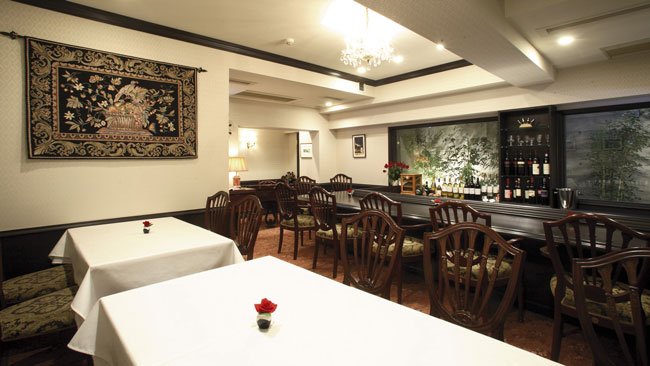
Originally published on metropolis.co.jp on August 2011

Anyone who knows anything about Hungarian food knows that “sophisticated” is close to the last word you’d use to describe it, but the fare served up at this Hungarian restaurant in Jingumae legitimately deserves such a description. Hearty favorites like gulyás (goulash) and pörkölt (stew), both staples of the Hungarian home kitchen, come artfully arranged on fine Zsolnay porcelain and finished with modern culinary flourishes.
Az Finom is found on a quiet side street near Harajuku. It is a small, traditionally decorated room—think white tablecloths, wooden cabinets, and paintings on the walls—that could have been a bar in a past life. We are the only guests, but the waitress is not overbearing; if anything, this means we get a chance to hear more about the ingredients and methods used to prepare each dish.
While the Tasting Course (¥6,500 for five courses plus tea or coffee) is tempting, we go for à la carte options. First up are a traditional gulyás soup (¥1,000 for small size) and a hideg meggyleves (cold cherry soup, ¥800; pictured). The gulyás soup has the familiar aroma of paprika and brims with generous chunks of beef and vegetables. Cherry soup could be considered an odd choice as a starter, but fruit soups are popular in Hungary and remind me of my childhood. Az Finom’s version manages to be both creamy and refreshing with just the right number of sweet, crunchy cherries.

This is followed by a Hungarian salami sausage taster plate (¥1,200) with two kinds of salami, which would have benefited from better bread and some gherkins, but is otherwise delicious. Our waitress explains that the salami is made with pork from Hungary’s unique Mangalica pigs. Next up is the foie gras on caramelized onion tatin with cocoa jelly (¥2,000). The foie gras is soft, rich, and perfectly cooked with a brown crust; it works well with the accompaniments. This is a great example of Hungarian ingredients served with a modern twist—and a standout dish.
Our mains include a special of the day, pork belly with bacon, sauerkraut and mashed potatoes (¥2,000), and a deconstructed marhahúsos pörkölt tojásos galuskával (beef stew with egg noodles, ¥2,000) that we are instructed to mix together. The pork is as soft as butter, and sets off well against the piquant sauerkraut and the smoky, satisfyingly chewy bacon cubes. Our misgivings about the size of the stew evaporate as soon as we taste the richness of the beef. The egg noodles have scrambled egg mixed through them, which is an unusual touch, and the dish is finished with an egg-white foam.
Our waitress helps us choose from the extensive and impressive wine list, most of whose items I have rarely seen outside Hungary. Kékfrankos (¥1200/glass) and Bikavér (the famous Bull’s Blood, ¥800/glass) reds complement our meals.
For dessert we have a chocolate palacsinta (pancake) with white chocolate mousse filling, and a rich peach tart with a chocolate base (both ¥800). These are delicious and rich without being filling. To cap off the meal, my brave dining companion has a bracing shot of pálinka (Hungarian fruit spirit, ¥800).
Our waitress comments that very few Hungarians visit the restaurant, and her theory is this is because nothing can compare to their mothers’ home cooking. After this meal at Az Finom, I can confidently say they’re missing out.





